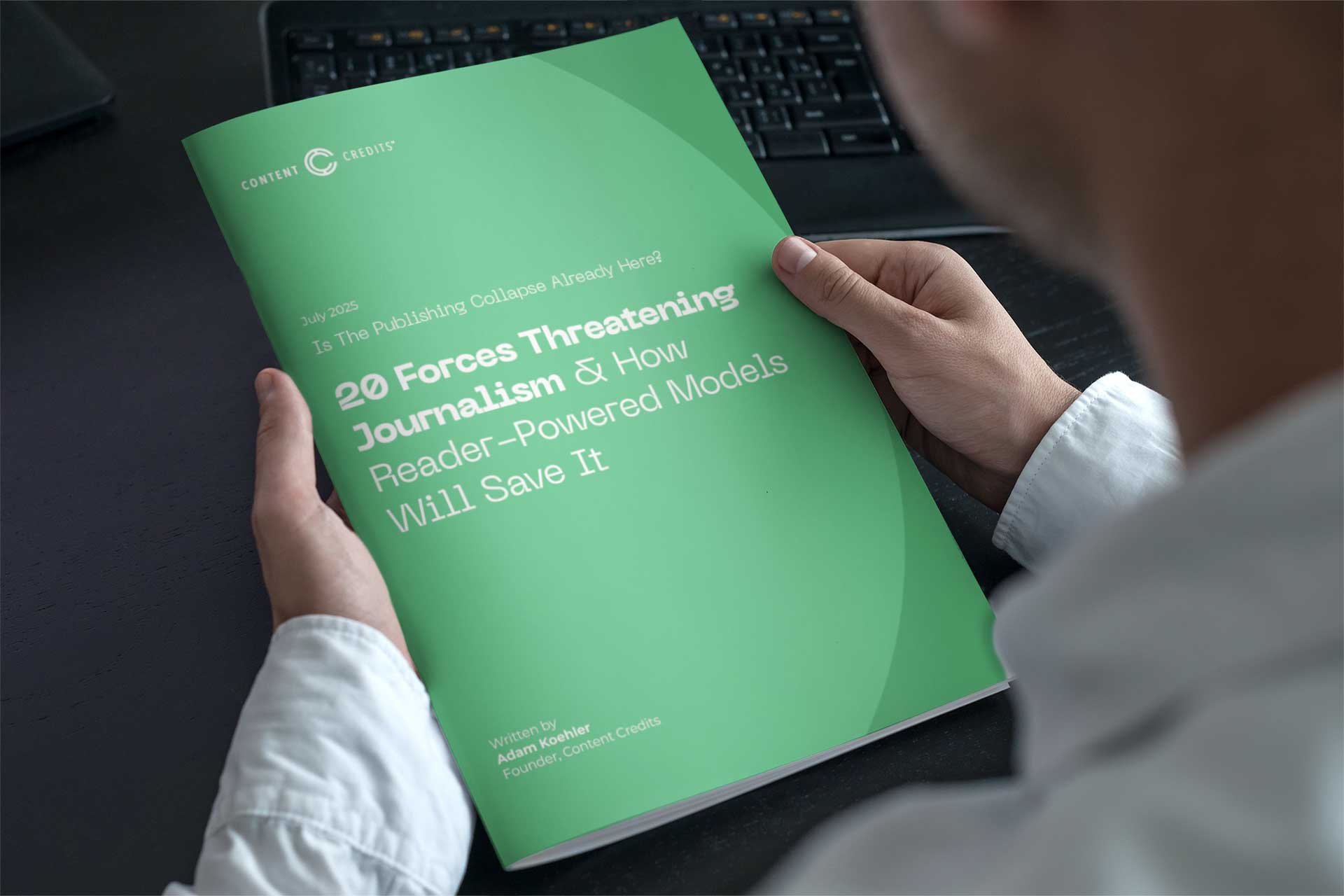The 20 Threats Facing Publishers—and the Model That Might Save It

Journalism is facing an existential crisis, and we have developed a list of the 20 threats facing publishers. Here’s why Content Credits is designed for the reality that subscription fatigue, zero-click AI, and platform censorship are already here.
The publishing industry isn’t on the brink of disruption—it’s already in free fall.
Over the past five years, journalism has been battered by a perfect storm of economic, technological, and cultural shifts that few media organizations were truly prepared for. Advertising revenue has cratered, undermined by the dominance of Google, Meta, and programmatic middlemen. Meanwhile, AI-powered content scraping is stealing traffic and value, replicating the work of real journalists without compensation or credit.
At the same time, direct traffic from loyal readers has been replaced by an algorithmic reality where news is filtered, suppressed, or reshuffled by platforms outside the publisher’s control. And with subscription fatigue on the rise, even trusted outlets are seeing more users churn—citing too many paywalls, too many monthly charges, and not enough flexibility.
In this environment, relying on ads or subscriptions alone is no longer sustainable. Most outlets are now monetizing just 2–3% of their readership, while the vast majority of readers remain invisible—interested in content but unwilling to commit.
That’s why we created a new white paper:
It’s a wake-up call—and a roadmap. If you’re in media, you need to see what’s coming next.
This isn’t theory. It’s not clickbait. It’s the reality publishers are facing every day:
- Google is turning into an answer engine, not a traffic driver
- Most users abandon a site when they hit a paywall
- Tools like Rocket Money and Experian are automatically canceling news subscriptions
- Generative AI is summarizing and mimicking journalism without credit or compensation
For most publishers, less than 3% of readers pay. And the 97% who don’t? They’re invisible.
We believe it’s time to meet those readers where they are—with an access model built on voluntary payment, not pressure.
Content Credits is a third rail for publishing.
Not ads. Not subscriptions. Something entirely new.
We call it the microtransaction layer—a lightweight, low-friction way for readers to support individual articles they care about without committing to a recurring charge or handing over their personal data. It’s built for the 97% of readers who will never subscribe, no matter how good the content is.
It’s already helping publishers:
-
Earn revenue from casual readers
-
Reduce reliance on platform distribution
-
Stay compliant with new FTC and state-level subscription regulations
-
Create a monetization funnel that doesn’t punish curiosity
We built this model because we’ve been watching how audiences actually behave. They’re browsing more, trusting less, and unsubscribing faster than ever. And they’re telling us something loud and clear:
“I want to support journalism. I just don’t want to subscribe to another thing.”
With Content Credits, now they don’t have to.
What’s in the white paper:
We break down the top 20 threats to journalism, including:
- AI scraping without compensation
- Subscription fatigue and economic pressure
- Ad blocker growth and low-margin monetization
- Regulatory changes targeting recurring billing
- Platform censorship and trust-score suppression
And we show how a simple, flexible reader-payment system like Content Credits is already starting to flip the model.
Who should read this?
If you’re a publisher, nonprofit newsroom, media founder, or anyone concerned about the future of journalism—you need to see the full picture. Because this isn’t about one issue. It’s about compound collapse: a layered set of economic, technological, and regulatory pressures converging all at once, threatening the very foundation of how news is created, funded, and distributed.
Download the full white paper here
Or reach out to us directly if you’d like to explore piloting Content Credits on your publication.
contentcredits.com | [email protected]
References and Supporting Research
Pew Research Center
Few Americans pay for news when they encounter paywalls
Only 1% of U.S. adults say they pay when they hit a paywall—most abandon or look elsewhere. This supports why casual access models are essential.
NPR
FTC cracks down on hard-to-cancel subscriptions with ‘click to cancel’ rule
New rules mandate that canceling a subscription must be as easy as signing up. Content Credits helps publishers avoid these regulatory pressures entirely.
New York Post
Google AI pummeling news sites as traffic dips across the board
Search engines are becoming answer engines, redirecting readers away from source journalism and stripping out context and attribution.
Press Gazette
Publishers back Cloudflare tool to block AI crawlers from scraping content
Major publishers are now fighting back against AI scraping, which devalues journalism while fueling competitor models.
West Virginia Watch
Some states want to make it easier to cancel subscriptions
New state laws are amplifying pressure on recurring billing models—highlighting the need for transparent, non-recurring options like Content Credits.